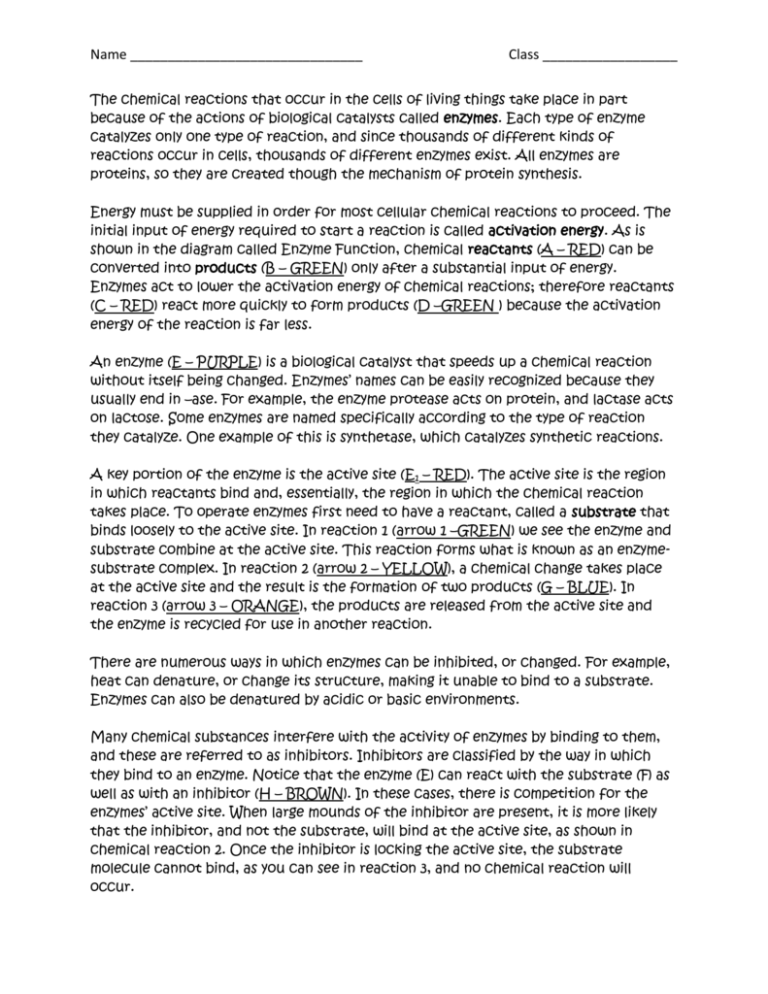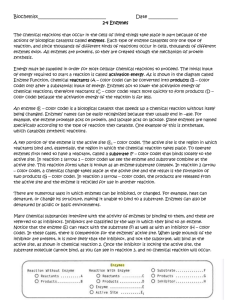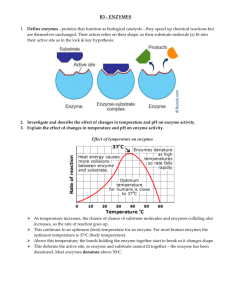Enzyme Questions and Coloring
advertisement

Name _______________________________ Class __________________ The chemical reactions that occur in the cells of living things take place in part because of the actions of biological catalysts called enzymes. Each type of enzyme catalyzes only one type of reaction, and since thousands of different kinds of reactions occur in cells, thousands of different enzymes exist. All enzymes are proteins, so they are created though the mechanism of protein synthesis. Energy must be supplied in order for most cellular chemical reactions to proceed. The initial input of energy required to start a reaction is called activation energy. As is shown in the diagram called Enzyme Function, chemical reactants (A – RED) can be converted into products (B – GREEN) only after a substantial input of energy. Enzymes act to lower the activation energy of chemical reactions; therefore reactants (C – RED) react more quickly to form products (D –GREEN ) because the activation energy of the reaction is far less. An enzyme (E – PURPLE) is a biological catalyst that speeds up a chemical reaction without itself being changed. Enzymes’ names can be easily recognized because they usually end in –ase. For example, the enzyme protease acts on protein, and lactase acts on lactose. Some enzymes are named specifically according to the type of reaction they catalyze. One example of this is synthetase, which catalyzes synthetic reactions. A key portion of the enzyme is the active site (E1 – RED). The active site is the region in which reactants bind and, essentially, the region in which the chemical reaction takes place. To operate enzymes first need to have a reactant, called a substrate that binds loosely to the active site. In reaction 1 (arrow 1 –GREEN) we see the enzyme and substrate combine at the active site. This reaction forms what is known as an enzymesubstrate complex. In reaction 2 (arrow 2 – YELLOW), a chemical change takes place at the active site and the result is the formation of two products (G – BLUE). In reaction 3 (arrow 3 – ORANGE), the products are released from the active site and the enzyme is recycled for use in another reaction. There are numerous ways in which enzymes can be inhibited, or changed. For example, heat can denature, or change its structure, making it unable to bind to a substrate. Enzymes can also be denatured by acidic or basic environments. Many chemical substances interfere with the activity of enzymes by binding to them, and these are referred to as inhibitors. Inhibitors are classified by the way in which they bind to an enzyme. Notice that the enzyme (E) can react with the substrate (F) as well as with an inhibitor (H – BROWN). In these cases, there is competition for the enzymes’ active site. When large mounds of the inhibitor are present, it is more likely that the inhibitor, and not the substrate, will bind at the active site, as shown in chemical reaction 2. Once the inhibitor is locking the active site, the substrate molecule cannot bind, as you can see in reaction 3, and no chemical reaction will occur. Name _______________________________ Class __________________ Enzyme Questions and Coloring Questions 1. What is an enzyme? _______________________________________________________ 2. All enzymes are _______________, that are created through protein synthesis. 3. The initial input of energy required to start a reaction is called ___________ _________. 4. Enzymes act to ____________ the activation energy of chemical reactions. 5. Enzymes end in ____________. 6. The region in which reactants bind and the chemical reaction takes place is called the ____________ ___________. 7. What are ways enzymes can be inhibited or changed? __________________________ ______________________________________________________________________ 8. What is an inhibitor? _____________________________________________________ Color and Label









